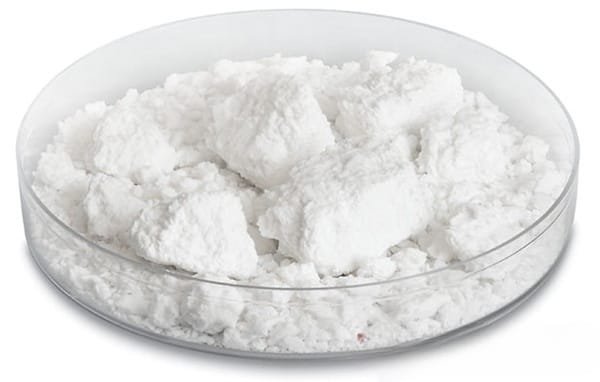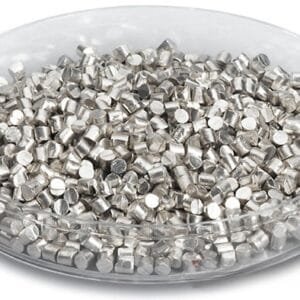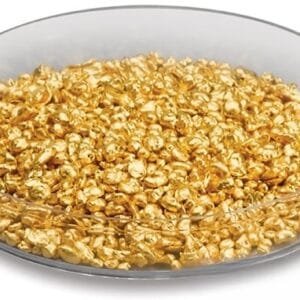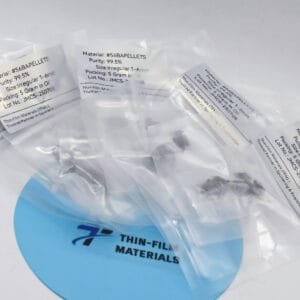Zinc Fluoride Evaporation Materials
Introduction
Zinc Fluoride (ZnF₂) Evaporation Materials are widely used in thin film deposition for optical and electronic applications. With its excellent transparency in the deep ultraviolet (DUV) to infrared range and strong resistance to moisture, zinc fluoride is an important material for producing anti-reflective coatings, beam splitters, and protective layers in advanced optical systems.
Detailed Description
Zinc Fluoride evaporation materials are typically supplied in the form of granules, pellets, or pieces with high purity levels (99.9%–99.99%). These materials are compatible with both thermal evaporation and electron beam (e-beam) evaporation systems.
Key features include:
High Optical Transparency: Transmits over a broad spectral range (0.2–7 µm).
Low Refractive Index (~1.37): Ideal for anti-reflective coatings.
Good Moisture Resistance: More durable compared to other fluorides like MgF₂.
High Purity: Ensures thin films with excellent uniformity and minimal contamination.
Thermal Stability: Stable under vacuum evaporation conditions.
Applications
Zinc Fluoride evaporation materials are used in:
Optical Coatings: Anti-reflective layers on lenses, prisms, and windows.
Infrared Optics: Thin films for IR detectors, imaging systems, and beam splitters.
Laser Systems: Optical coatings for high-power UV and IR laser components.
Semiconductor Industry: Protective dielectric films in electronic devices.
Research & Development: Optical thin film studies in universities and labs.
Technical Parameters
| Parameter | Typical Value / Range | Importance |
|---|---|---|
| Purity | 99.9% – 99.99% | Higher purity ensures defect-free optical films |
| Forms Available | Pellets, granules, pieces | Adaptable to different evaporation sources |
| Refractive Index | ~1.37 (at 550 nm) | Ideal for anti-reflective applications |
| Transmission Range | 0.2 – 7 µm | Broad spectrum optical use |
| Evaporation Method | Thermal / e-beam | Flexible for various thin film systems |
Comparison with Related Materials
| Material | Key Advantage | Typical Application |
|---|---|---|
| Zinc Fluoride (ZnF₂) | Good moisture resistance, broad IR use | Anti-reflective coatings, IR optics |
| Magnesium Fluoride (MgF₂) | Lower refractive index, excellent UV transparency | AR coatings, laser optics |
| Calcium Fluoride (CaF₂) | High mechanical strength, wide IR range | Windows, prisms, IR optics |
FAQ
| Question | Answer |
|---|---|
| What forms are available? | Zinc Fluoride is offered as pellets, granules, and pieces to fit thermal and e-beam evaporators. |
| How is it packaged? | Vacuum-sealed in moisture-proof containers with protective outer cartons or crates. |
| Can it be customized? | Yes, purity level, size, and shape can be tailored for specific requirements. |
| What is the delivery time? | Typically 2–3 weeks depending on order size and customization. |
| Which industries use it most? | Optics, semiconductors, laser technology, and research institutions. |
Packaging
Zinc Fluoride evaporation materials are moisture-sensitive and therefore carefully vacuum-sealed or packed in inert gas environments. Each container is labeled with purity, batch number, and specifications. Protective foam and export-safe cartons ensure safe transportation and storage.
Conclusion
The Zinc Fluoride Evaporation Materials provide a reliable source for producing high-quality thin films with excellent optical transparency, durability, and low refractive index. They are essential in advanced optical coatings, infrared systems, and semiconductor applications.
For detailed specifications and a quotation, please contact us at sales@thinfilmmaterials.com.


 MSDS File
MSDS File



Reviews
There are no reviews yet.